Cruise Shore Excursions: Theater off the Sea
By Linda Gasparello
To take or not to take shore excursions. That is the question for cruisers.
Having cruised on five continents, my answer is to take them. The guides are competent — mostly moonlighting high school teachers and college professors — and often they’re characters.
The first cruise my husband, Llewellyn King, and I took, on the Black, Aegean and Adriatic seas in the early 1990s with the now-defunct Royal Cruise Line, introduced us to shore tour theater.
In Constanta, Romania’s largest and most important port city on the Black Sea, our shore excursion guide was a droll fellow named Mikhail. We visited the city not long after dictator Nicolae Ceausescu and his wife, Elena, were tried by a hastily arranged military tribunal that was set up on Dec. 25, 1989, put up against a wall and shot, all within an hour. It was a city still in shock from 24-years of their mismanagement that brought food shortages in a country with dark, rich soil; torture and executions; and, most famously, state neglect of orphans and disabled children.
During our tour of the city, we stopped at a Belle Epoque hotel where, Mikhail told us, “Nazi leaders lodged comfortably in the early years of World War II.” The hotel manager made us feel welcome by setting out trays with tiny fruit tarts and small glasses of tuica (Romanian “white lighting” made from plums) on a large table in a paneled, ground-floor reception room. As we entered the room, the staff, who stood at the opposite end, watched as most of us sampled the tarts and tuica. As the last person in our group walked out of the room, I looked back and saw the staff make a dash for the table, grabbing whatever was left.
We traveled north to the Greco-Roman city of Histria. Mikhail gave us a detailed tour of the city, which was founded by Greeks in the 7th century BC and thrived for seven centuries. He interspersed his commentary about Histria, which became the richest city in Ionia (Asia Minor), with sarcastic comparisons to Romania’s “golden age under the Ceausescus.”
We returned to Constanta on a coastal road. Nearing the city, we saw thick pipes that seemed to stretch for miles along a beach. “That would be a beautiful beach, but the pipes lead to a chemical plant that Mrs. Ceausescu built. She had a doctorate in chemistry, but she did not even graduate from high school. Fancy that!”
Mikhail said Mrs. Ceausescu was nicknamed “Codoi,” referring to her mispronunciation of the chemical compound CO2 ( “C” for carbon, “O” for oxygen, and “doi” which is Romanian for “two”). He added that “codoi” was a word in Romanian, too, meaning “big tail.”
“Her big tail was her nose. She would kill anyone who took her picture in profile,” he said.
For nine days this month, Llewellyn and I cruised the Baltic Sea on the Getaway, a Norwegian Cruise Line megaship. Anna, our guide on a day cruise along the Neva River in St. Petersburg, was a notable shore tour entertainer.
On the bus, as we drove from the cruise ship to the river boat, Anna told us that men in Russia were “as precious as diamonds. So ladies, hold onto your husbands. Do not lose them. And please send us your sons, nephews, brothers, uncles.”
Anna teaches Russian history in a St. Petersburg high school, and she wrangled us as though we were her students on a field trip. She taught us how to say “I love you” in Russian. “Ya lyublui vas. Just say, ‘yellow blue bus.’ We Russians are so emotional.”
The sunny day brought out what Anna called her “Russian emotions.” Pointing to the buildings decorated like wedding cakes along the river, many designed by the 18th-century Italian architects Bartolomeo Rastrelli and Carlo Rossi, she said, “Rastrelli, who built the Winter Palace, which you can see along the embankment, liked pale blues and greens, and Rossi liked pale yellow. These colors make us happy. They are good for our emotions.”
So, too, is vodka. Anna said, “When you have a cold, you drink vodka with lemon. When you have a headache, you drink vodka with pepper. And when you are depressed, you drink vodka.”
But the funny lady was serious about showing us St. Petersburg’s historical sights: no significant edifice on the banks of the Neva or ship moored on it (including the great, gray cruiser Aurora which fired the blank round at 9:45 p.m. on Oct. 25, 1917 that started the Bolshevik Revolution) escaped her commentary.
“Just look at the taste and temperament of Peter the Great. Here is his small, elegant Summer Palace. But across the river, on Vasilyevsky Island, is the Peter and Paul Fortress, which he designed. It was the Bastille of the tsars,” Anna said.
Across from the fortress, she pointed to the Soviet-era KGB (now FSB) headquarters. “That’s the ‘Big House,’ ” she said.
Those of us seated on the upper deck were grateful that Anna was serious about reminding us to duck when we approached one of the many low bridges across the Neva.
“Please keep seated,” she said. “But if you want to be like Catherine the Great and get rid of your husband, have him stand up.”
How emotional, how Russian.
Matroyshkas and Movies: A Souvenir Shop in St. Petersburg
While I prefer to go to souvenir shops of my own volition, I’ve stopped resenting being shanghaied into them on cruise shore excursions. Sometimes, they’re sights that shouldn’t be missed, like the Grand Bazaar in Istanbul: a maze of souvenir shops.
After our Neva River day cruise, we were bussed to a cavernous souvenir store. Norwegian Cruise Line billed it as a “bathroom stop.”
It was just that, for some on our bus. But busloads of tourists, including many on ours, were just raring to hit the mirrored shelves laden with fur hats, amber jewelry, Faberge-style Easter eggs and matroyshka dolls — especially after getting emotional on complimentary cranberry vodka, served at the entrance by young women wearing traditional, red jumper dresses.
Against a wall, near one of the store’s side exit doors, stood colossal Presidents Vladimir Putin and Donald Trump matroyshka dolls. As I took a picture of them, I heard one shopper say, “Same size as their egos.”
The store occupies part of what was once a movie theater in St. Petersburg. The theater’s architecture is Stalinist big box. The huge concrete-slab marquee over the entrance advertised four movies or other events. Riveted onto cement columns near the entrance are metal sheets imprinted with scenes of bears frolicking in a forest, peasants threshing wheat, and people going about their business on a wintry day in St. Petersburg. There is one of Russian troops tending their wounded in the Crimean War – a war that stirs up sacred memories, leading to actions even unto this day.
Power Tower
More is more. That was the approach of the two greats, Peter and Catherine, and Empress Elizabeth asked their European architects to take in St. Petersburg.
The city’s historic center is a feast — a grand bouffe — of Baroque and Neoclassical buildings, including the Admiralty, the Winter Palace, and the Marble Palace. UNESCO designated it a World Heritage site in 1990, noting, “The unique urban landscape of the port and capital city of Saint Petersburg, rising out of the Neva estuary where it meets the Gulf of Finland, was the greatest urban creation of the 18th century.”
The more-is-more approach is operating today with the construction of the Lahkta Center, which includes a twisting glass-and-steel tower that will serve as the headquarters of the state-owned energy giant Gazprom. The project, which was proposed in 2005, has changed its name (as many times as St. Petersburg) and location, due to criticism from preservationists and residents that its 1,515-foot tower — which will be the tallest in Russia — would destroy the city’s horizontal harmony and violate a law prohibiting new buildings higher than 157 feet in the historic center.
In 2010, the project moved to a site northwest of Vasilyevsky Island, overlooking the Gulf of Finland. It is scheduled for completion in 2018.
Designed by the architectural firm RMJM London, the center’s website says “the tower bears more than a passing resemblance to a ship’s mast, while the building that lean against its base represent the hull. This theme continues through the wave-like bearing structures and the overall organic form of the building, both of which symbolize the power of the sea.”
The project already holds a Guinness World Record. Between Feb. 27 and March 1, 2015, it set a new record for largest continuous concrete pour, with 25,667 cubic yards poured over a period of 49 hours.
Some of the Lakhta Center’s remarkable innovations include:
- It will be the first skyscraper in St. Petersburg to employ an ice formation-control system. To prevent ice accumulations and help maintain good visibility, the glass on the highest floors will be heated; and to prevent ice formation, the tower’s spire will be made of metal gauze.
- The center’s lighting will be designed to make it bird-safe during migration in the fall and winter months, complying with the World Wide Fund for Nature and FLAP’s (Fatal Light Awareness Program) bird-friendly building program.
This project has Petrine boldness. While it could suit a man who would be a great, Putin, he has yet to weigh in on it.
Gallery
Neva River Sights
- “The Big House”: Former KGB, now FSB, headquarters.
- The legendary cruiser Aurora, docked at Petrogradsky embankment.
- snowberry of mine!”
- “Little snowberry,
- The Admiralty with the golden dome of St. Isaac’s Cathedral behind it.
- St. Isaac’s Cathedral houses a large Russian Orthodox museum.
- The roof of the Senate and Synod building, designed by Carlo Rossi.
- The Senate and Synod building, built for the two most important administrative organs of the Imperial Russian government.
- The Kunstkammer is Peter the Great’s curiosity museum.
- Bronze statue of Peter the Great building a boat.
- The Admiralty is the former headquarters of the Admiralty Board and the Imperial Russian Navy in St. Petersburg, Russia and the current headquarters of the Russian Navy.
- Rossi’s mellow yellow buildings.
- Neva tour boat traffic.
- Peter the Great’s summer hideaway.
- The beautiful blue Naval Academy.
- The Peter and Paul Fortress: Imperial Russia’s Bastille.
- Work boat on the Neva.
- Folk singers perform “Kalinka” on a Neva riverboat.
- snowberry,
- The Faberge Museum has its own pier and river tour boats.
Street Life
- Chinese tourists line up outside The Hermitage.
- Teenagers enjoying summer stroll near one of St. Petersburg’s gardens.
- A downtrodden man in St. Petersburg with his dogs.
Soviet Movie House / Souvenir Shop
- Imperial Easter eggs in a souvenir shop.
- A wooden Ded Moroz (Grandfather Frost), the Russian Santa Claus.
- The double-door entrance to a Soviet movie theater, now a souvenir shop.
- The movie theater marquee.
- A column near the movie theater entrance with a picture of bears frolicking in the woods.
- Another column with a picture of Russian troops tending their wounded during the Crimean War.
- Maybe the last event at the movie theater.
Graffiti
- Graffiti tops a building along the Neva River.
- Russian eyes (ochi chornyye) peer out of a corner of a building along the Neva River.




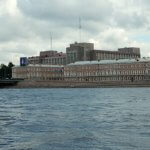





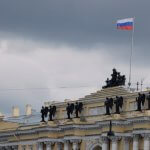


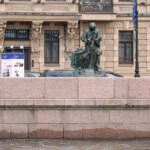







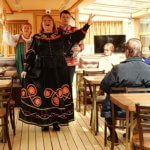





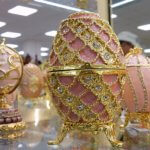




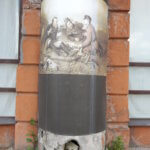



 Follow
Follow
Leave a Reply